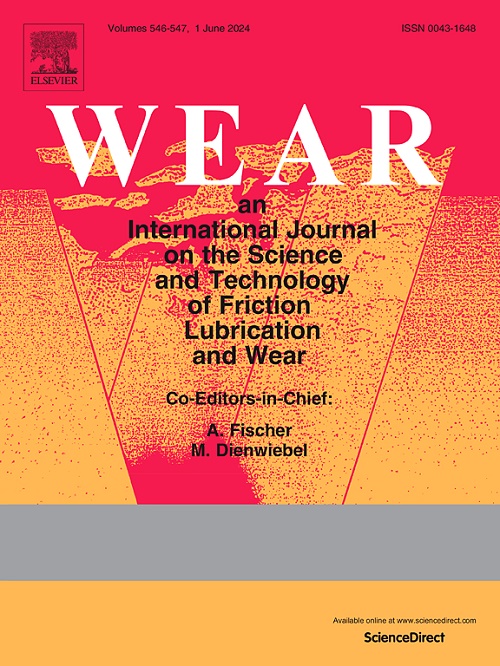拉曼分析对微纳米碳化硅增强PEEK摩擦学研究的贡献
IF 5.3
1区 工程技术
Q1 ENGINEERING, MECHANICAL
引用次数: 0
摘要
本研究考察了不同尺寸和浓度的碳化硅颗粒增强聚醚醚酮(PEEK)复合材料的摩擦学行为。在不同载荷(2.5%、5%、7.5%和10%)下填充纳米级和微型SiC颗粒的复合材料,使用球-板摩擦计评估其耐磨性和摩擦性能。利用拉曼光谱跟踪磨损轨迹内PEEK基体的结晶度变化,发现在高应力区域,特别是SiC含量较高的区域,存在明显的非晶化现象。研究结果表明,纳米级SiC颗粒比微米级SiC颗粒具有更好的摩擦减量性能,当填料含量为5-7.5%时性能最佳。在高性能应用中,纳米级SiC颗粒通过减少摩擦同时保持结构完整性来提高摩擦学性能。然而,由于磨损碎片的不稳定性,高SiC含量导致微增强或纳米增强复合材料的磨损增加。该研究强调了颗粒尺寸和填料含量对改善摩擦性能的重要性,并指出进一步研究磨损和分子定向失向机制可以提高PEEK-SiC复合材料的性能。本文章由计算机程序翻译,如有差异,请以英文原文为准。
Contribution of Raman analysis on tribological study of PEEK reinforced with micro or nano SiC particles
This study examines the tribological behavior of polyetheretherketone (PEEK) composites reinforced with silicon carbide (SiC) particles of varying sizes and concentrations. The composites, filled with both nano- and micro-sized SiC particles at different loadings (2.5%, 5%, 7.5%, and 10%), were evaluated for their wear resistance and friction properties using a ball-on-plate tribometer. Raman spectroscopy was employed to track crystallinity changes in the PEEK matrix within the wear tracks, revealing significant amorphization in high-stress regions, especially with higher SiC content.
The findings show that nano-sized SiC particles provide superior reduced friction compared to their micro-sized counterparts, with optimal performance at 5–7.5% filler content. Nano-sized SiC particles enhance tribological performance by reducing friction while maintaining structural integrity in high-performance applications. However, higher SiC content led to increased wear in both micro- or nano-reinforced composites due to the instability of the wear debris. The study emphasizes the importance of particle size and filler content in improving tribological properties and suggests that further investigation into the mechanisms of wear and molecular disorientation could enhance the performance of PEEK-SiC composites.
求助全文
通过发布文献求助,成功后即可免费获取论文全文。
去求助
来源期刊

Wear
工程技术-材料科学:综合
CiteScore
8.80
自引率
8.00%
发文量
280
审稿时长
47 days
期刊介绍:
Wear journal is dedicated to the advancement of basic and applied knowledge concerning the nature of wear of materials. Broadly, topics of interest range from development of fundamental understanding of the mechanisms of wear to innovative solutions to practical engineering problems. Authors of experimental studies are expected to comment on the repeatability of the data, and whenever possible, conduct multiple measurements under similar testing conditions. Further, Wear embraces the highest standards of professional ethics, and the detection of matching content, either in written or graphical form, from other publications by the current authors or by others, may result in rejection.
 求助内容:
求助内容: 应助结果提醒方式:
应助结果提醒方式:


